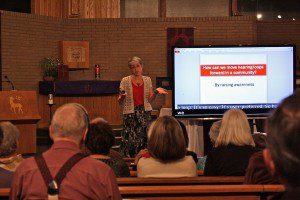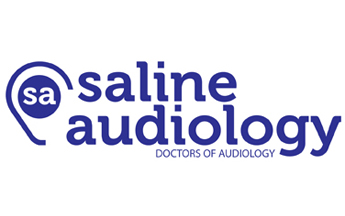Hear The Difference With A Loop

People who are affected by hearing loss do not necessarily have trouble hearing sound. They just have trouble distinguishing the sound, says Dr. Juliette Sterkens. “We tell people with hearing loss to listen harder, but that’s very difficult” she says. People with hearing loss — now over 48 million in the United States and 16 percent of Buncombe county residents — have trouble hearing soft noises, have trouble making out sounds when there is a lot of background noise and are made uncomfortable by loud sounds. So, despite some misconceptions, volume is not really the issue. “My number one challenge is background noise,” says Kathy Borzell, who is hard of hearing. Borzell and her sister Rosemary Tuite founded the Brevard chapter of the Hearing Loss Association to support and inform other people who have hearing loss. “We live in a noisy world. Hearing loss makes understanding speech in noisy situations challenging.” And turning up the hearing aid does not help many people with hearing loss, according to Sterkens. “Hearing aids cannot always correct the problem,” she says.
In a talk given at St. Eugene’s Catholic Church in North Asheville on March 10, Dr. Juliette Sterkens, an audiologist from Wisconsin, introduced attendees — many of whom were older and hard of hearing — to the hearing loop. This assistive technology uses a magnetic field, installed through copper wiring running through the floor of a room or building, to transfer sound from a device like a microphone to any hearing aid or cochlear implant that has a telecoil (a wire commonly found in hearing aids which picks up magnetic signals).
According to Sterkens, assistive technology like the hearing loop overcomes distance, reverberation and background noises, which are all cited as common problems with hearing aids. The technology transfers sound from a microphone directly into the listener’s ear through their hearing aid. With the hearing loop technology, Borzell says, “background noise is not an issue.”
But like any technology, it has its limitations. Because sound must be picked up through a magnetic field, the hearing loop can only be used in settings when a microphone or similar device is in use. This technology has been around for several years and has excelled in many European countries, but has only recently grown in popularity in the United States. Churches have been the more common users of this new technology, Sterkens says, but other spaces and businesses are catching on. Hearing aid offices, libraries, drive-through banks, airports, grocery store check outs, auditoriums, courthouses, even New York City subway information booths have implemented hearing loops.
The technology is wireless and does not require additional gadgets for people with telecoils in their hearing aids. The wireless feature sets it apart from other special hearing devices that are often available in public settings like theaters and museums, but are often neglected, Sterkens says. “You have to pick up the device, you have to pray that the batteries work, that it’s clean, that it works,” she says. “And every device looks different. In my 30 years of experience [as an audiologist] I couldn’t get my clients to pick them up. A lot of people don’t want to sit in a theater with headphones.”
Assistive technology helps decrease isolation, says Tuite. “[Before], I felt alone,” she says. “I retreated more and more. Today, with the technology we have, life can be so much less stressful.” And this can make all the difference for the growing number of people with hearing loss in the United States. According to Sterkens, “everybody deserves to hear this way.”
Micah Wilkins March 13, 2014
Leave a reply
